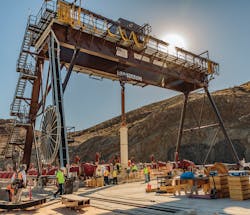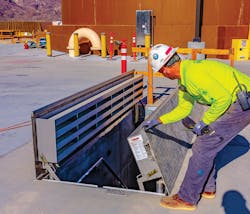By Thomas Renner
For nearly two decades, several western states have been grappling with a severe water crisis brought on by climate change. In May 2019, federal officials and leaders from seven states signed the Colorado River Drought Contingency plan, a new water management agreement designed to reduce risks from the ongoing drought and protect the most important water resource in the region.
In an interview with the Las Vegas Sun in January, the Southern Nevada Water Authority (SNWA) described the Colorado River as “the lifeblood of the Southwest.” The river is responsible for an economic output of $1 trillion and 16 million jobs rely directly on the river. Snowpack flows into the river, and the water is used by communities all along its 1,450-mile path.
The Las Vegas Valley gets about 90 percent of its water from the Colorado River. The water level of Lake Mead, which serves as the source of the community’s drinking water, has dropped more than 130 feet since January 2000 and the federal government is projecting a high probability that Lake Mead water levels may fall below 1,075 feet in 2021, triggering the first-ever shortage of Colorado River water and possibly reducing the amount of water available to Nevada. Other states might also be affected by the water level drop at Lake Mead. If the lake dips below elevation at 895 feet, Hoover Dam, which sits just seven miles from Lake Mead, can no longer release water downstream to California, Arizona and Mexico.
The SNWA is a group of seven local water and wastewater agencies that serves more than 2.1 million residents in Southern Nevada. It is responsible for water treatment and delivery, as well as acquiring and managing long-term water resources for Southern Nevada. Next year, the agency will put into operation one of the most elaborate, expensive and largest pumping stations to help ensure water delivery to its customers. The $650-million project, called the Low Lake Level Pumping Station, broke ground in mid-2015 and will have the capacity to deliver up to 900 million gallons a day to two water treatment facilities.
The pumping station will not draw additional water out of Lake Mead. “It is a backup, redundant pumping station to use in the event our other two pumping stations are unable to pump due to lowering lake levels,” said Erika Moonin, SNWA project manager. In essence, the project is a big, sophisticated and necessary safety net designed to make certain SNWA’s customers receive water. Dire forecasts make the project an essential part of the region’s long-term viability.
“The Bureau of Reclamation is the governing body that forecasts watershed along the Colorado River,” Moonin said. “It will take many years of incredible snowpack for Lake Mead, Lake Powell and other reservoirs to recover from this long-standing drought and the consequences of climate change.”
A Look at the System
The system designed for the project is as unique as it is complex. It includes a 525-foot-deep access shaft, with a 26-foot finished diameter. There are also 34 deep well shafts equipped with submersible pumps that feed the pumping station. Barnard of Nevada Inc. serves as the general contractor for the project and worked closely with the SNWA and the construction manager, Parsons.
Among the first steps in the project was to create a forebay, a 12,500-square-foot cavern that is 500 feet beneath the pumping station. Pumps draw water from the forebay — an oversized water retention area — which then enters header pipe and flows through two large-diameter aqueduct systems to deliver water to two treatment plants. Twenty-two low lift pumps will deliver raw water to the Alfred Merritt Smith Water Treatment Facility, and 12 high lift pumps will deliver raw water to the River Mountains Water Treatment facility. Once at the treatment plants, the water is treated with ozone and then goes through a filtration system before entering the transmission system and, ultimately, the homes in the Las Vegas valley.
Defining and developing the size of the forebay was one of the most complex tasks in the project. Moonin said engineers performed many case studies and calculations to determine the size, depth and final dimensions of the forebay. “A scale model was developed at Utah State and tests were performed to assess the many factors of how water entered the forebay from the intake tunnel, how it traveled to each of the 34 well shafts, its velocity, and more,” Moonin said. “Engineers used the data from this model testing, among many other things, to determine the appropriate size of the forebay.”
The Big Dig
The pumps are no small part of the project, and neither was the matter of placing them into the ground.
The team first created the forebay, access shaft and riser shaft by drilling and blasting. Crews removed more than 58,000 cubic yards of blasted rock. SNWA said crews used 271 controlled blast rounds and more than 98,000 pounds of package blasting explosive materials. The forebay was completed in the summer of 2018. Concurrently, workers used the blind bore drill method to excavate 34 pump shafts. The shafts reached 500 feet down to a precise location in the forebay.
The pumps are among the most powerful on the market. The 22 low lift pumps, which weigh approximately 68 tons, are 23 feet long and can produce up to 30 million gallons of water per day, according to Moonin. The high lift pumps weigh 79 tons and are 28 feet long and can also produce 30 million gallons of water per day. They were deposited into the cavern with a gantry crane with a capacity of 220 tons.
Creation of the forebay and shafts proved to be one of the most challenging tasks of the entire project, Moonin said. “The rock is hard but fractured, and water flows through the fractures with direct connectivity to Lake Mead,” Moonin explained. “In order to proceed with excavating the underground caverns and well shafts in these challenging work conditions, a significant grouting program was used to prepare the ground for drilling of the well shafts and drill-and-blast excavation of the forebay.”
Core sampling and extensive geotechnical studies helped identify as many ground conditions challenges as possible, Moonin said, and the grouting campaign and careful excavation led to successful completion of the underground work.
Closing the Door on Water
Valves at the pumping station are protected by 12 floor doors manufactured by The BILCO Company of Connecticut. The doors are strategically placed on the project’s vaults, which house and provide access to large-diameter valves. The doors are reinforced for AASHTO H-20 wheel loading.
Single- and double-leaf doors were used in the project, which will allow workers to access valves that require adjustment and perform maintenance on the pumps. Although the doors are quite large and heavy, they are supplied with BILCO’s engineered lift assistance to ensure safe and easy one-hand operation.
“There are conduits and drain lines that required access,” said Tyler Askin, Barnard’s project engineer at Lake Mead. “The doors were a product that one of our suppliers had used in the past and had the most experience with, and the specifier thought they would be a good choice, especially for this application.”
Addressing a Community Need
While costly, high-risk and extremely labor-intensive, the project is a must-have for Las Vegas. The lingering drought and declining water level of Lake Mead have left the Southern Nevada Water Authority with few options.
Already, conservation efforts have helped reduce the community’s Colorado River consumption, according to the Las Vegas Water District. The community used 27 billion gallons less water in 2018 than in 2002, even as the population increased by 690,000 residents. But more needs to be done, which is why the Low Lake Pumping Station is such a critical piece of infrastructure for Las Vegas.
“It’s really an unsung project, but it’s important for the Las Vegas community to guarantee its water supply,” Askin said. “It’s one of those projects a lot of people are unaware of. It’s not alongside a highway where you can see progress every day. Water’s not something people think about it until they don’t have it. This will help make sure that doesn’t happen.” WW
About the Author: Thomas Renner writes on building, construction, manufacturing and other topics for trade publications throughout the United States and Canada.



